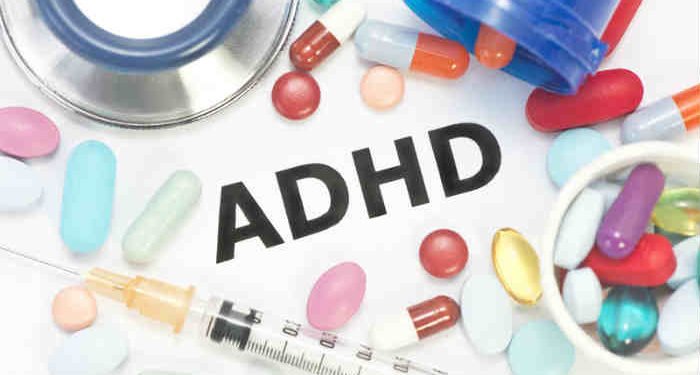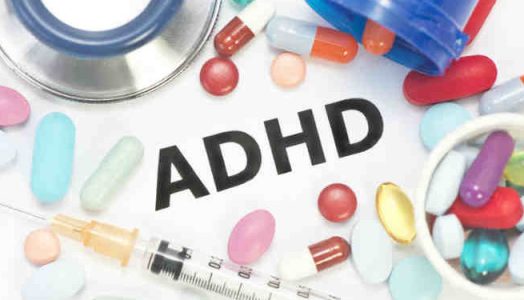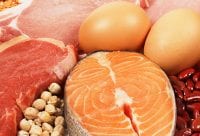Personal Food Sensitivities/Allergens
An ADHD diet should exclude top common allergens, including peanuts, tree nuts, shellfish, wheat, conventional dairy and eggs. Personal sensitivities to foods should also be removed from the diet. This may include papaya, avocados, bananas, kiwis, chocolate, fennel, caraway and coriander.
Foods That Improve the Symptoms of ADHD
According to a study published in Psychiatry Research, there is a direct link between dietary behaviors and ADD/ADHD and learning disabilities in children and adolescents.(source) In this study, a high intake of sweets, fried foods and salt was associated with more learning, attention and behavioral problems.In contrast, a balanced ADHD diet is shown to have beneficial effects on all of the problems caused by a poor diet. To change to an ADHD diet, avoid the foods mentioned above while eating a diet of unprocessed, whole foods. Modern Western diets seem to be more closely liked to ADHD because of the higher consumption of refined sugars, salt and hydrogenated fats, while being low in omega-3s, fiber, folate and B-Complex. (source)
High-protein meals that include clean sources of protein from grass-fed organic beef, free-range chicken, eggs, wild-caught fish and raw dairy should be the focus of an ADHD diet for both children and adults.
Iron-Rich Foods
Low iron levels are associated with fatigue, poor concentration and mental function, irritability, poor memory, muscle weakness, and leaky gut syndrome. Eating a diet rich in high iron foods is an essential part of a successful diet strategy for ADHD. Iron rich foods include the liver and steaks from grass-fed beef, navy and black beans, spinach, Swiss chard, and egg yolks.
Foods High in B-Vitamins
Vitamin B-6 is essential for brain function, including the production of dopamine and serotonin. In a preliminary study, B-6 was shown to be slightly more effective than Ritalin in improving behavior among hyperactive children. (source)
Vitamin B-6 rich foods are tasty and easy to incorporate into the ADHD diet. Wild tuna and salmon, free-range chicken and turkey breast, grass-fed beef, bananas, cooked spinach, sweet potatoes, and hazelnuts hit the top of the list. In addition, include brewer’s yeast and other green leafy vegetables.
Poultry
The essential amino acid, tryptophan, helps the body synthesize proteins and support healthy serotonin levels. In many individuals suffering from ADD/ADHD, imbalances in serotonin levels is indicated. (source) Additionally, serotonin is related to impulse control and aggression, two of the symptoms of ADD/ADHD. (source)
When adding both free-range turkey and chicken to the diet, avoid frying the poultry and stick with recipes like my kid-friendly, baked chicken teriyaki or herbed turkey breast — both are great for quick leftover lunches and dinners.
Foods Rich in Probiotics
Yogurt and kefir from grass-fed cows or goats, sauerkraut, Kimchi, and other high probiotic foods should be a central part of a diet for ADHD.
Eggs
Eggs are a great way to incorporate high-quality protein into the ADHD diet, and they are not just for breakfast anymore. Each egg has 7 grams of protein, but is also packed with essential amino acids and omega-3 fatty acids. Purchase local, organic eggs, preferably from cage-free chickens.
Omega-3 Foods
Foods rich in omega-3’s — such as wild-caught salmon and tuna — directly affect cognitive function in both children and adults. A clinical trial identified a link between low levels of omega-3 fatty acids and behavioral and learning problems. (25) A successful ADHD diet will include two or more servings per week of salmon or tuna. Try my cilantro salmon burgers — a recipe that comes together quickly and is a big family-pleaser.
Natural Treatment for ADHD: SUPPLEMENTS
 Prominent researchers from the Division of Neurology at Children’s Memorial Hospital and Department of Pediatrics at Northwestern University Medical School reviewed substantial research regarding diet and ADHD. While diets were shown to be difficult to sustain, adding supplementation to diet therapy was an easy step to take and typically more acceptable to kids. (source)
Prominent researchers from the Division of Neurology at Children’s Memorial Hospital and Department of Pediatrics at Northwestern University Medical School reviewed substantial research regarding diet and ADHD. While diets were shown to be difficult to sustain, adding supplementation to diet therapy was an easy step to take and typically more acceptable to kids. (source)
Fish Oil & Omega 3 Complex
Fish oil is better than Ritalin for ADHD, according to a study from the University of Adelaide in Australia.The omega-3 fatty acids, including DHA and EPA, within fish oil are critical for brain function and are also strong anti-inflammatories. Children 50 to 80 pounds should be given one teaspoon daily; children 80 to 150 pounds, two teaspoons daily; adults should take one tablespoon daily.
Supplementation appears to reduce symptoms of ADHD, improve learning, reduce anxiety and depression, and help prevent some forms of cancer. Another study published in the Journal of American Academy of Pediatrics found that supplements offer a safe treatment option for educational and behavioral problems in children. Significant improvements in reading, spelling and behavior were all noted over the three-month trial.(source)
Zinc
Children and adults with ADHD should supplement their diets with a high-quality zinc supplement. Low levels of zinc are associated with poor neurological function, poor attention and a variety of motor disorders.
The World Health Organization reports that zinc deficiency rate is 31 percent. One of the leading symptoms of a zinc deficiency is poor neurological function. In addition to high-quality mineral supplements, it’s important to add mineral rich foods, such as dark greens, beans and wild-caught salmon.
Serotonin
One of the genetic links to ADHD is the serotonin transporter gene. Serotonin levels are directly linked to aggression and impulse control. (source)
B-Complex
Children with ADHD typically need more of the B-vitamins to help maintain focus, increase concentration, fight stress, relieve fatigue, balance energy and hormone levels, and produce healthy levels of serotonin. Children and adults should take 50 milligrams daily.
Probiotics
Children and adults should take 25 billion to 50 billion units of probiotics daily. In addition to taking a high-quality probiotic supplement, aim to eat foods high in probiotics, such as kefir, sauerkraut, raw cheese and yogurt.
Some studies show that ADHD may be connected to problems in the digestive tract. Sugar, tap water, grains, certain prescription medications, including antibiotics, and environmental chemicals kill healthy bacteria in the gut and decrease digestive function.
GABA (Gamma-Amino Butyric Acid)
GABA is an amino acid vital to healthy central nervous system function. It acts as a calming agent, helping to suppress nervous system activity and block some nerve impulses. Individuals should take 250 milligrams twice per day.
Speak to your physician prior to taking GABA if you are on any medications, or if any of the following side effects arise: wheezing, anxiety, flushing, or tingling of the hands and feet.
Magnesium
Magnesium is essential in regulating central nervous system excitability thus magnesium-deficiency may cause aggressive behavior, depression, or suicide.[2] Magnesium calms the brain and people do not need to become severely deficient in magnesium for the brain to become hyperactive. One study confirmed earlier reports that a marginal magnesium intake overexcites the brain’s neurons and results in less coherence–creating cacophony rather than symphony—according to electroencephalogram (EEG) measurements.
There is an epidemic of magnesium deficiency in America and in populations around the world. This is, in part, what is driving such surges in violence? The two most basic requirements for the normal operation of our brain are a sufficient energy supply and an optimal presence of biochemicals involved in transmitting messages. Magnesium is crucial in both the production of energy and neurotransmitters, not to mention the integrity of the blood brain barrier. It is bedrock science that connects magnesium to neurological disorders.
Medical science is clear though that magnesium deficiency or imbalance plays a role in the symptoms of mood disorders. Observational and experimental studies have shown an association between magnesium and aggression anxiety ADHD bipolar disorder depression and schizophrenia. Patients who had made suicide attempts (by using either violent or nonviolent means) had significantly lower mean CSF magnesium level irrespective of the diagnosis.
Mg deficiency increases susceptibility to the physiologic damage produced by stress. The adrenergic effects of psychological stress induce a shift of Mg from the intracellular to the extracellular space, increasing urinary excretion and eventually depleting body stores. – Dr. Leo Galland
It took four days before the first elite controlled media published one of the main reasons all these people in Vegas had to die. The killer was on massive dosages of Valium (diazepam). He was prescribed 50 10mg diazepam pills in June. In a shameful article, we read that most doctors agree it is near-impossible for a pill to be the root cause of Paddock’s murder spree killing 58 and wounding more than 500.
What does it take to get the government to ban all of these dangerous medications and to substitute magnesium, bicarbonates and even iodine in their place?
As the world joined Americans in mourning the school massacre in Connecticut, many urged U.S. politicians to honor the 28 victims, especially the children, by pushing for stronger gun control laws. If they were honest they would be urging the US government to finally put a stop to the criminal and vicious attack on children by Big Pharma.
Natural Treatment for ADHD: LIFESTYLE & OTHER TREATMENTS
Successful treatment for the symptoms of ADHD requires not only supplements and healthy diet void of known ADHD triggers, it also requires some lifestyle changes. The natural treatments mentioned below can help many ADHD symptoms.
1. Essential Oils
 Lavender essential oil can be used in various ways to improve mood when anxiousness or nervousness is present. As with other essential oils, drops can be added to the bath, sprinkled on stuffed animals, used in diffusers, or even applied directly to the skin or bottoms of feet at bedtime. Dilute with a carrier oil like grape seed oil or coconut oil or apply only one to two drops if using the concentrated oil.
Lavender essential oil can be used in various ways to improve mood when anxiousness or nervousness is present. As with other essential oils, drops can be added to the bath, sprinkled on stuffed animals, used in diffusers, or even applied directly to the skin or bottoms of feet at bedtime. Dilute with a carrier oil like grape seed oil or coconut oil or apply only one to two drops if using the concentrated oil.
Also, consider using Peppermint Oil, which improves mental focus, boosts energy and helps to release tight muscles.
2. Sleep
Insomnia and restless sleep are common ADHD symptoms. A recent study found that behavioral sleep intervention improves the severity of ADHD symptoms in children, especially those taking prescription stimulants. The study showed behavior, quality of life and functioning was sustained for six months following the trial. (source)
It’s vital that both children and adults develop good evening routines that allow them to unwind at the end of the day. The goal should be a good eight hours of sleep each night.
3. Eat Breakfast
For some people, and especially those with ADHD, breakfast helps the body properly regulate blood sugar and stabilize hormone fluctuations. Eat a breakfast that contains at least 20 grams of protein. My Thin Mint Protein Smoothie has 20 grams of protein from whey and is sure to please kids and adults of all ages.
4. Exercise
Exercise helps to increase hormone levels that are essential for relieving ADHD symptoms. (source) Prior to a task that requires concentration, engage in 30 minutes of moderate exercise.
5. Balance/Stability Balls
According to the American Journal of Occupational Therapy, using balance/stability balls as a seat increased attention levels, decreased hyperactivity and increased time on task. (source) If your child’s school will not allow a stability ball, be sure to use one at home during homework. In addition, adults can benefit from stability balls at their desks.
6. Neurofeedback
Neurofeedback may help children and adults learn to focus on tasks. Some initial studies have found that watching brain activity during neurofeedback allows some individuals the opportunity to learn how to more effectively control their brains.
Symptoms of ADHD can be reduced with diet, supplements and recommended lifestyle changes — moreover, these changes can help you conquer ADD/ADHD in yourself, or in your child. For many people, removing the trigger foods and replacing them with healthy foods will dramatically help address this common neurological and behavioral disorder.
- Marian S. McDonagh, Kim Peterson, et al., Drug Class Review of Pharmacologic Treatments for ADHD: Final Report Update 2, Portland, Oregon Health & Science University, (2007). Available here (accessed 13 February 2009).
- Alexander Otto, ‘Are ADHD drugs safe? Report finds little proof’, The News Tribune, 13 September 2005. Available here (accessed 13 February 2009).
- ibid
- ibid
- Oregon Health & Science University, Drug Class Review on Pharmacologic Treatments for ADHD, Portland, Oregon, 2007, p. 24.
- ibid., p. 20.
- ibid., p. 16.
- ibid., p. 19.
- ibid., p. 21.
- Peter Breggin, ‘A Critical Analysis of the NIMH Multimodal Treatment Study for Attention-Deficit/Hyperactivity Disorder (The MTA Study)’ in Psychiatric Drug Facts 2000. Available here (accessed March 20 2008); The MTA Study was ‘the first multisite, cooperative agreement treatment study of children, and the largest psychiatric/psychological treatment trial ever conducted by the (U.S.) National Institute of Mental Health. It examines the effectiveness of Medication vs. Psychosocial treatment vs. their combination for treatment of ADHD and compares these experimental arms to each other and to routine community care.’ K. C. Wells, W. E. Pelham, et al., ‘Psychosocial treatment strategies in the MTA study: rationale, methods, and critical issues in design and implementation’, (abstract), Journal of Abnormal Child Psychology, Vol. 28, No. 6, 2000. Available here (accessed 7 February 2008).
- The study was sponsored by the National Institute of Mental Health (NIMH) and conducted at six separate US sites. At each site, the study compared four treatment conditions: medication management alone, combined medication management and behavioural therapy, behavioural therapy, and community care. The average age of the children was eight and 80 per cent were boys. For more information, see The MTA Cooperative Group, ‘A 14-Month Randomized Clinical Trial of Treatment Strategies for Attention-Deficit/Hyperactivity Disorder’, Archives of General Psychiatry, 56, 1999, p. 1073.
- Merle G. Paule, Andrew S. Rowland, Sherry A. Ferguson, et al., ‘Attention deficit/hyperactivity disorder: characteristics, interventions, and models’ in Neurotoxicology and Teratology, Vol. 22, No. 5, 2000, p. 631. Available here (accessed 13 February 2009).
- Allegra Stratton, ‘Questions raised about drugs as treatment for ADHD sufferers’, The Guardian, November 12th, 2007. Available here (accessed 26 March 2008).
- Brooke Molina, Kate Flory, Stephen P. Hinshaw et al., ‘Delinquent Behavior and Emerging Substance Use in the MTA at 36 Months: Prevalence, Course, and Treatment Effects’, Journal of the American Academy of Child & Adolescent Psychiatry, Vol. 46 No. 8, August 2007: pp. 1028–1040; Stratton, ‘Questions raised about drugs as treatment for ADHD sufferers’.
- Joseph M. Rey, ‘In the long run, skills are as good as pills for attention deficit hyperactivity disorder’, The Medical Journal of Australia, 188:3, 2008, p. 134.
- The Raine Study started in 1989, when 2900 pregnant women were recruited into a comprehensive health and wellbeing research study at King Edward Memorial Hospital to examine ultrasound imaging. The mothers were assessed during pregnancy and after the children were born, and at one year, then two, three and five years of age. Information on their height, weight, eating, walking, talking, eating, behaviour, any medical conditions or illness etc. was collected. Further follow ups of the cohort have been conducted at eight, ten, fourteen, and seventeen years of age. At each follow-up information is collected from the parents and the child. The current follow up is being done at twenty years of age. By age fourteen ‘of the 1785 adolescents (remaining) in the sample, 131 (7.3 per cent) had received a diagnosis of ADHD’. At age five none of the 131 had taken ADHD stimulants. By age fourteen, twenty-nine had never taken stimulants, forty-one had been on prescription stimulants in the past but were not taking them, and sixty-one were on ADHD stimulants. This gave three groups for comparison, the ‘never medicated’, ‘previously medicated’ and the ‘currently medicated’ groups. In addition analysis of the effect of the duration of stimulant treatment was undertaken. Available here (accessed 7 May 2010). The statistically significant differences that existed at age fourteen occurred between age five and fourteen, after some of the children were medicated. To the extent that (non-statistically significant differences) existed at age five these were controlled for by using the “propensity for medication” score, the symptom severity before commencement of medication treatment, and a number of sociodemographic measures’.
- Government of Western Australia, Department of Health, Raine ADHD Study: Long-term outcomes associated with stimulant medication in the treatment of ADHD in children, Department of Health, Perth, 2010.
- ibid., p. 52.
- ibid., p. 6.
- ibid., p. 5.
- ibid., p. 30; The short term studies referred to in the Raine Study are Howard B. Abikoff, et al., ‘Methylphenidate effects on Functional Outcomes in the Preschoolers with Attention-Deficit/Hyperactivity Disorder Treatment Study (PATS)’, Journal of Child and Adolescent Psychopharmacology, 17(5), 2007, pp. 581–92; C. L. Carlson & M. R. Bunner, ‘Effects of Methylphenidate on the Academic Performance of Children with Attention-Deficit Hyperactivity Disorder and Learning Disabilities’, School Psychology Review, 22(2), 1993, pp. 184–98; Irene M. Loe & Heidi M. Feldman, ‘Academic and educational outcomes of children with ADHD’, Journal of Pediatric Psychology, 32(6), 2007, pp. 643–54.
- Government of Western Australia, Department of Health, Study raises questions about long-term effect of ADHD medication, Media Release, 17 February 2010.
- Russell A. Barkley, et al., ‘International Consensus Statement on ADHD’, Clinical Child and Family Psychology Review, Vol 5, No. 2, June 2002, p. 89.
- Sami Timimi, et al., ‘A Critique of the International Consensus Statement on ADHD’, Clinical Child and Family Psychology Review, Vol. 7, No. 1, 2004, p. 59.
- ibid.
- ibid p.60.
Sources:
- http://www.speedupsitstill.com/pseudoscience/
- https://draxe.com/symptoms-of-adhd/
- https://breggin.com/childrens-page/
- https://www.lewrockwell.com/2018/05/mark-sircus/pharmaceutical-murder-mass-shootings-caused-by-drugs/





